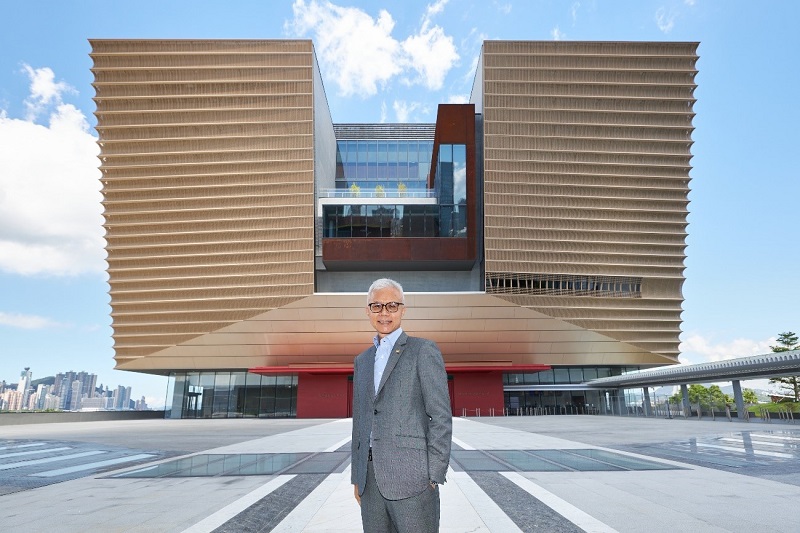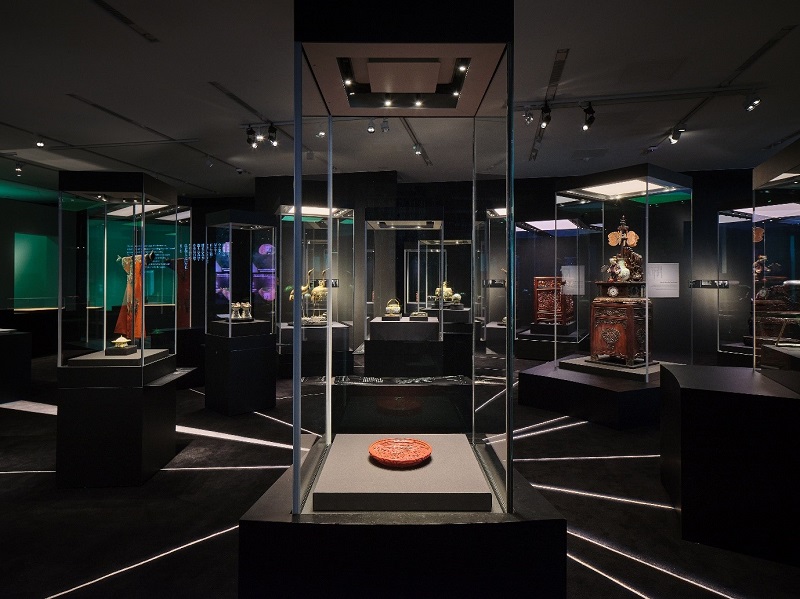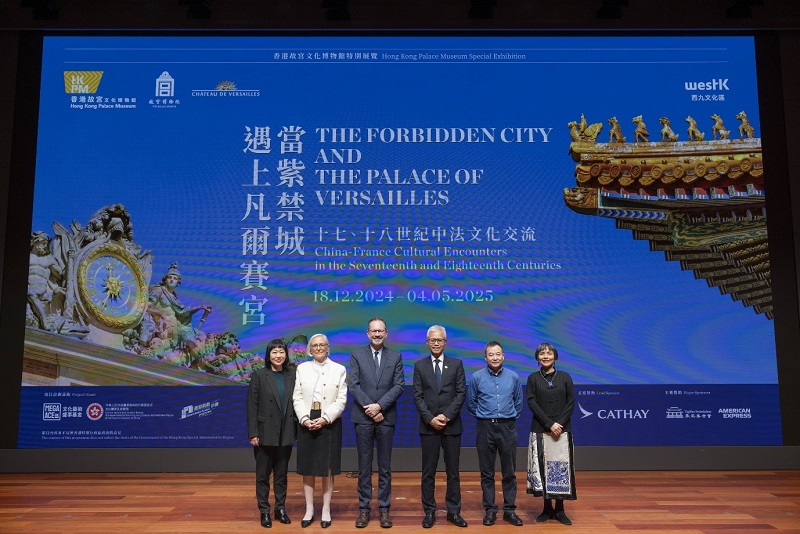Besides supporting cultural tourism, the Hong Kong Palace Museum sees its mission as helping build a community with a shared future for all.

Dr. Louis Ng, director of the Hong Kong Palace Museum (HKPM), says the museum’s mission is to put Hong Kong on the global cultural map.
When history student Louis Ng first visited The Palace Museum in Beijing, also known as the Forbidden City, the imperial palace where a succession of Chinese emperors lived for nearly five centuries, it was a jaw-dropping experience for the 19-year-old.
“I live in Hong Kong, a small city with skyscrapers and modernized buildings, and suddenly I found a palace.” Five thousand years of history flooded his mind and he found it incredible to be in a place where major historical events had happened and important decisions had been made.
It was 1982. At the time he had no idea that one day he would have a “lifelong relationship” with the institution. Thirty-seven years later, he became the museum director of the Hong Kong Palace Museum (HKPM), the newest cultural landmark in the special administrative region of China.
The HKPM opened to the public in July 2022 with more than 1,500 precious items loaned by The Palace Museum in Beijing, including “national treasures.” Ng says some of them have not been seen even by Chinese mainland residents. And now, people from the mainland are flocking to Hong Kong to view them.
Setting a New Trend
As China’s holiday economy was off to a swinging start with the eight-day Spring Festival break, the HKPM saw an upsurge in the number of visitors. “Many cultural facilities, including government museums, closed on the first and second day of the Chinese New Year. But we only closed on the first day,” Ng said.
Also, while normally the HKPM remains closed on Tuesdays, during the Spring Festival holiday, it was open on Tuesday as well. “I think we made a very, very wise decision,” he said.

The exhibition “The Quest for Originality: Contemporary Design and Traditional Craft in Dialogue” at the HKPM.
On an average, there were 6,000 visitors daily, showing a remarkable change in the profile of visitors. Over 80 percent were from the Chinese mainland. In 2024, the total number of visitors was about 1 million. Visitors from the mainland and “areas under China” formed about 50 percent of the number, international tourists accounted for 20 percent, and locals made up the rest. East and Southeast Asia contributed a significant number, especially South Korea, Japan, Singapore, Thailand and Indonesia.
Before the HKPM opened, almost 70 percent of museum visitors in Hong Kong were locals. “It's showing that the HKPM has become an international museum,” Ng said.
Besides the Spring Festival, the National Day “golden week” in October, the Labor Day holiday in May, and the school holiday in summer are important tourism seasons when mainland tourists flock to Hong Kong.
Improved transportation is a key factor for this mass arrival. The Hong Kong High-Speed Rail that opened in 2018 directly connects Hong Kong with several cities in the southern part of the mainland and the network continues to expand. The Hong Kong-Zhuhai-Macao Bridge, also opened in 2018, connects the three destinations, slashing travel time from three hours to 30 minutes. These have facilitated trips to Hong Kong and Macao especially for residents of the Guangdong-Hong Kong-Macao Greater Bay Area (GBA).
“Visitors from the GBA can visit the museum, have a day trip and lunch, do some shopping and then go back,” Ng said. “Previously, people came to Hong Kong mainly for shopping, for food. But now they are looking for new attractions. Because of the improvement of the overall income, they are looking for high quality tourism products.”
He waves a newspaper cutting he has been sent by Carrie Lam, former chief executive of Hong Kong. It’s a write-up about the HKPM’s new special exhibition, The Forbidden City and The Palace of Versailles: China-France Cultural Encounters in the Seventeenth and Eighteenth Centuries. The columnist lauds it, saying Hong Kong should have this kind of high quality cultural products.
Special Status, Special Mission
“For all our exhibitions, our programs, we are looking for the best in Asia. We are no longer a local museum. We have the mission to put Hong Kong on the world (cultural) map” Ng said. “We need to make use of Hong Kong’s special status and position to promote cultural exchange between China and the rest of the world.”
In just two and a half years, the museum has done a significant amount of exchanges. It has had a number of collaborative exhibitions with several countries and museums, including the Palace of Versailles, the Musée des Arts Décoratifs (Museum of Decorative Arts) and the Louvre in France, and the National Gallery in London. This year, three major exhibitions are lined up with diversified partners.

Guests attend the press conference of “The Forbidden City and the Palace of Versailles: China-France Cultural Encounters in the Seventeenth and Eighteenth Centuries” special exhibition in December 2024 at the HKPM. Photos courtesy of the HKPM
“This morning I had a meeting with the consul-general of Egypt to talk about the upcoming special exhibition on ancient Egyptian civilization,” he said. It has special significance because in 2026, China and Egypt will celebrate 70 years of their diplomatic relations. “Through this exhibition Hong Kong people can know more about Egypt and ancient culture.”
Another major collaboration will be with the Museum of Islamic Art in Doha, Qatar, and the General Collections of Qatar Museums. Slated as Hong Kong’s first major Islamic art exhibition, “Imperial Carpets: Masterpieces from the Museum of Islamic Art, Doha” will run from June to October, showcasing carpets from Iran, Türkiye, and India, along with ceramics, metalwork, manuscripts, and jades.
This is also a nod to the ancient Silk Road and Maritime Silk Road as China enjoyed flourishing trade and cultural exchanges with the Islamic world as early as during the Tang Dynasty (618–907) by land and sea.
The third major collaboration is with the Victoria and Albert Museum in London to present “Treasures of the Mughal Court”, art from the Indian subcontinent during the reign of the Mughal emperors from about 1560 to 1660. “Also, we have signed a number of MoUs with a lot of museums, including some French museums, in the U.K., in Japan, in Spain,” Ng said. “We also organized some international conferences on conservation.”
This year, the HKPM will also send out its first traveling exhibition because “cultural exchange is two-way.” Capital Museum in Beijing will host the HKPM’s collection of nearly 1,400 ancient Chinese gold and silver objects generously donated by two renowned collectors, Betty Lo Kenneth Chu. “Our team is international, we understand the cultures of other countries, and there's no language barrier,” Ng said. “That's why we can promote mutual understanding of civilizations. Especially, now, (in) the current international political situation, we have to do more to enhance trust and understanding.”
Harnessing Hi-Tech
Technology is one effective way of doing that. The HKPM plans to become a smart museum using artificial intelligence (AI) and digitization. “Now we have about 5,000 objects in hand, so we are going to use two years to digitize them. Whether for research, education, exhibition or cultural enterprise, you can easily use our images for your education program, even for commercial use. So digitalization is very important.”
The HKPM has been holding augmented reality/virtual reality exhibitions to provide an immersive experience for visitors. And of course AI is a must to enhance visitor service. “Now we have English and Chinese (language services). We would like to use AI to provide multi-language service.”
In six months’ time, the HKPM hopes to have a study done on exploring AI applications, which will also provide a model for reference for other museums. “Technology development is very important,” Ng stressed. “You can see the larger talking point about DeepSeek. That’s Chinese technology. We can see (Chinese) technology development can support museum and other cultural developments.”
Then the reach can extend to a wider audience, not just those physically visiting museums. He lauds the work done by mainland museums to nurture online visits and the use of social media such as TikTok to disseminate cultural resources. The HKPM will also explore the media.
However, it will carve out its own path. “Hong Kong is a modern city, and we try to connect the objects and history with present-day life. We present the objects in our exhibitions in a very different way. For example, we commission some Hong Kong artists to produce some contemporary art in dialogue with some historical objects, so people can see the past, and view the present. This is a modern museum. It’s about the future of the past.”
He feels museums in China are seeing “a craze, a boom.” China already has around 7,000 museums that notched up 1.29 billion visits in 2023. The HKPM’s unique role is that it is also a means to strengthen the cultural roots between Hong Kong and the mainland. “Visitors from the mainland can understand more about Hong Kong’s role in the preservation and promotion of Chinese art and culture, know more about Hong Kong people, about our city, about our past. It can enhance understanding between Hong Kong and mainland citizens because now we have become one country and one area – the GBA.”
Also, the HKPM’s exhibitions enhance Hong Kong residents’ understanding about Chinese art and culture, their origin and diversity. “It's very important to consolidate the national identity, to establish cultural confidence,” he says. “If you lose your confidence about the country, about history, about the past, you can then not meet the challenges. We are now a strong country, a big country. We have a responsibility to promote our common destiny, (as) advocated by President Xi Jinping, to build a community with a shared future for mankind.”